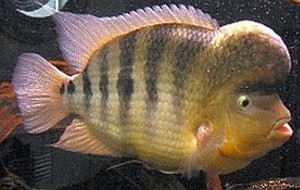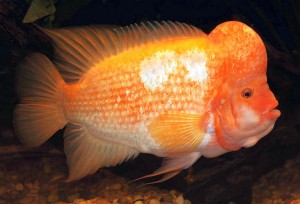The Midas cichlid (Amphilophus citrinellum) is endemic to the San Juan River in Nicaragua and Costa Rica, and is one of the most belligerent cichlids known to tropical fish keeping enthusiasts. They are frequently confused with the Red Devil cichlid (Amphilophus labiatus) which has larger lips, a smaller nuchal hump and less thickly set in appearance.
The Midas Cichlid prefers large lakes, ponds, and slower moving areas of large rivers where they tend to favor living among the rocky walls and banks where they can easily forage among the crevices for smaller fish, a variety of mollusks, and plant materials. They have powerful jaws, sharp teeth, and are extremely aggressive in the wild as well as in an aquarium environment.
Midas Cichlids exist in several color forms dependent on where they have been collected. Some specimens are colored pink, white, yellow, orange and gold, but most wild caught specimens are grey to olive brown in color with a characteristic pattern of black horizontal banding.
The more brightly colored forms (called “golds”) exist naturally throughout their range. In nature, the males have nuchal humps which in aquarium specimens, have become more accentuated by selective breeding through several generations.
Mature males are more “well built” than females, have longer dorsal and anal fins, and possess a more pronounced nuchal hump. The genital papilla in males is thinner and more elongate than the papilla in females.
In the wild, the nuchal humps only develop during the breeding season, however, in an aquarium environment many show specimens possess enormous, permanent humps.
Extensive hybridization between Amphilophus citrinellum and other species has produced white, grey, yellow, orange, gold, red, barred and piebald forms as well as the Flowerhorn and Parrot Cichlid.
Not surprisingly, it is the more colorful variants that have become the most popular with tropical fish keeping enthusiasts.
Midas Cichlids should NOT be housed in a densely planted tank. They are fond of shifting around large quantities of substrate and will quickly destroy any well decorated aquarium, regardless of size.
They can be housed in a large aquarium with a gravel substrate, some pieces of driftwood, plenty of rocks for cover, and a even a few large flowerpots. You can try using anchored plastic plants, but expect them to be rearranged on a regular basis. These fish are so aggressive that they will even attack unprotected heaters, filter outlets, etc. unless they are placed behind some heavy rocks or anchored with strong suction cups.
They require an efficient filtration system and weekly water changes to deal with the huge amount of waste these messy fish produce. An outside canister filtration system is recommended to maintain water quality and keep the dissolved oxygen levels in the tank elevated. Large air stones can also be provided to maintain the required oxygen levels.
Because Midas Cichlids are so aggressive, they need an extremely large tank with plenty of rock work and driftwood to minimize their behavior, especially if they are to be housed with other fish. Although it is possible to keep them with other aggressive Central American cichlids like Convicts, Jack Dempseys, Oscars, Green Terrors, Umbees as well as large catfish, large Loricariids, and even large fast swimming fish like tinfoil barbs or silver sharks, but they are best kept isolated in a “show” tank.
Breeding Midas Cichlids is fairly straightforward provided you can obtain a compatible pair however, getting a compatible pair is the problem. It is possible to pair up adult fish by placing a tank divider in the breeding tank and letting the potential pair get used to each other for a few weeks before removing the divider. Unfortunately, this does not always come to a successful conclusion.
A better method is to purchase at least 6 or more juveniles, raise them together, and allow them to pair off naturally. When a pair forms, the other fish in the tank should immediately be removed from the tank to prevent them from being killed.
Once you have a pair they will usually breed without too much more encouragement from you. Place the pair in at least a 6 foot wide tank with plenty of rocks and heavy flowerpots to act as potential spawning sites and feed them live foods to get them into spawning condition. The increased size of the nuchal hump of both sexes indicates that the fish are in spawning condition.
Spawning is usually a violent affair that can be quite prolonged. Both fish will exhibit gaping, tail slapping and a lot of digging behavior. When ready to spawn, the ovipositor of the female will be clearly visible and the female will rub her lateral line along the hump of the male. If the male does not turn on the female and kill her, the pair will lay eggs inside a flower pot, cave, or on a vertical rock where the male fertilizes them. Both parents care for the eggs and will viciously defend their territory, so keep your hands out of the tank during this period.
The eggs will hatch in 2 to 3 days and the fry will be moved to a pit excavated in the substrate. The fry become free swimming 5 to 7 days later and at this point, a divider should be placed into the tank to protect the female from the male. Leave the fry in the tank or the male may get confused and try to mate with the female a second time and potentially kill her.
The fry grow quickly and should initially be fed brine shrimp until they are able to accept dried foods. When they are born they are gray in color but will begin to change colors when they are about 2″ to 2 1/2″ in size.
Midas Cichlids are not fussy eaters and will try to eat anything you put in the tank. They do best on a staple diet of high quality cichlid sticks with regular supplements of live, frozen, or freeze dried foods such as prawns, earthworms, mussels, shrimp, and blanched peas or spinach. They should not be fed red meats or beef heart since these high protein foods can cause digestive problems. Because Midas Cichlids predate on other fish in their natural habitat, many tropical fish keeping enthusiasts feed them live “feeder” fish, however in an aquarium environment, diseases can be introduced into the system and there is little proof that any benefit results in feeding them live fish.
Despite it’s aggressiveness, the Midas Cichlid is one of the most popular aquarium species among cichlidophiles. They have great personalities and quickly learn to recognize their owners. They also seem to display a greater level of intelligence than other aquarium species and can even be trained to perform tricks in reward for food.
Midas Cichlids are available online at reasonable prices in sizes from 2″ to 4″ in size and as adults.
Minimum Tank Size: 100 gallons
Care Level: Difficult
Temperament: Super Aggressive
Aquarium Hardiness: Hardy
Water Conditions: 69.8-78.8° F, KH 5-25, pH 6.0-8.0
Max. Size: 12-14”
Color Form: Gray, Orange, Red, Yellow
Diet: Omnivore
Compatibility: Single species tank
Origin: Nicaragua, Costa Rica
Family: Cichlidae
Lifespan: 10-15 years
Aquarist Experience Level: Advanced






I will soon have a cichlid called the (RED PHOENIX KING CICHLID). Which is from South and Central America and grows up to a large 32 inches and can kill a Midas or red devil cichlid.